Did you know that cucumber seeds have the potential to yield hundreds of cucumbers in a single season? From salads to pickles, these versatile vegetables are a favorite among gardeners and food enthusiasts alike. Whether you’re a beginner or a seasoned gardener, this article will provide you with essential tips for successfully growing cucumber seeds and introduce you to a variety of cucumber seed varieties available in the market.
Ready to dive into the world of cucumber cultivation? Let’s get started!
Key Takeaways:
- Choose the right cucumber seed variety for your growing conditions and culinary preferences.
- Start cucumber seeds indoors to get a head start on the growing season.
- Directly sow cucumber seeds outdoors once the soil temperature reaches 70º F.
- Provide proper spacing, sunlight, and water for optimal cucumber plant growth.
- Support cucumber plants with trellises and consider pruning for maximizing space and airflow.
Starting Cucumber Seeds Indoors: A Step-by-Step Guide
Starting cucumber seeds indoors is a great way to get a head start on the growing season. By following this step-by-step guide, you can ensure healthy seedlings that are ready for transplanting outdoors.
- Start the seeds 4 to 6 weeks before the outdoor planting date. This allows the seedlings to grow strong before being exposed to the elements.
- Use individual containers for each seedling. This helps prevent root entanglement and allows for easy transplanting later on.
- Choose a seed-starting growing medium that is lightweight and sterile. This provides the necessary nutrients and moisture retention for optimal seed germination.
- Plant the cucumber seeds at the recommended depth, typically about 1 inch deep. Be sure to follow the instructions on the seed packet for specific guidelines.
- Keep the soil moist but not waterlogged. Overwatering can lead to root rot, so it’s important to find the right balance.
- Place the containers in a location that receives direct light. Cucumber seedlings need around 14-16 hours of light each day for healthy growth.
- Rotate the containers daily to ensure even exposure to light. This prevents the seedlings from leaning towards a single light source.
- Monitor the seedlings closely for any signs of pests or disease. If necessary, treat accordingly to prevent further damage.
When the cucumber seedlings reach several inches tall and have true leaves, it’s time to transplant them outdoors. This usually occurs around the same time as the last spring frost date in your area. Be sure to harden them off gradually, exposing them to outdoor conditions for a few hours each day before transplanting them permanently.
Transplanting cucumber seedlings requires careful handling to prevent damage to the tender roots. Dig a hole in the soil and gently remove the seedling from its container, taking care not to disturb the roots. Place the seedling in the hole, backfill with soil, and gently firm it around the base of the plant.
Now, your cucumber seedlings are ready to thrive in their new outdoor home. In the next section, we will discuss best practices and tips for planting cucumber seeds outdoors.
Planting Cucumber Seeds Outdoors: Best Practices and Tips
When it comes to planting cucumber seeds outdoors, there are a few best practices and tips to keep in mind for a successful harvest. Direct sowing is an excellent method for starting cucumbers, and it offers several advantages. First, it eliminates the need for transplanting, reducing the risk of transplant shock. Second, it allows the seeds to establish roots directly in the garden soil, promoting vigorous growth. Here are some key steps to follow:
- Wait for the Right Temperature: Cucumber seeds thrive in warm soil, so it’s crucial to wait until the soil temperature reaches around 70ºF (21ºC) before planting. This ensures optimal germination and early growth.
- Prepare the Planting Holes: Dig small holes in the garden bed, spaced 18 to 60 inches apart, depending on the cucumber variety. The holes should be deep enough to accommodate the seeds while leaving room for proper growth.
- Sow the Seeds: Plant 2 to 3 cucumber seeds per hole, placing them about 1 inch deep. This increases the chances of successful germination and ensures a higher yield. Remember to label each hole or row to keep track of the cucumber varieties.
- Thinning the Seedlings: Once the cucumber seedlings start growing and have a few leaves, thin them out to provide adequate space for each plant to thrive. Remove the weaker seedlings, leaving only the strongest one in each hole.
It’s important to keep the soil moist after planting cucumber seeds outdoors. Regular watering is essential to ensure proper germination and early growth. However, you should avoid overhead watering to prevent potential diseases, such as powdery mildew. Consider using a drip irrigation system or watering at ground level to deliver water directly to the roots.
Expert Tip: Covering the young cucumber plants with row covers or cloches can provide additional protection against unexpected frosts. This is especially important during the early stages of growth.
Cucumbers thrive in rich, well-draining soil that receives full sun. Before planting, amend the soil with compost or well-rotted manure to improve its fertility and drainage. This will provide the necessary nutrients for healthy cucumber growth. Additionally, ensure the garden bed has good air circulation to prevent diseases.
Proper Spacing
Proper spacing is crucial for healthy cucumber plants. It allows for good air circulation and prevents overcrowding, which can lead to diseases and poor fruit development. The recommended spacing between cucumber plants varies depending on the specific variety:
| Variety | Spacing |
|---|---|
| Bush Variety | 18 to 24 inches apart |
| Vining Variety on Trellis | 24 to 36 inches apart |
| Vining Variety on the Ground | 36 to 60 inches apart |
By following these best practices and tips for planting cucumber seeds outdoors, you’ll be well on your way to a bountiful harvest of crisp and delicious cucumbers.
When and Where to Plant Cucumbers for Optimal Growth
Planting cucumbers in the right location and at the right time is crucial for their optimal growth. Here’s what you need to know:
Choosing the Best Time
Cucumbers thrive in warm weather, so it’s important to wait until all danger of frost has passed before planting them outdoors. The ideal time to plant cucumbers is between the last spring frost and the first fall frost. This ensures that the weather is consistently warm, providing the perfect conditions for cucumber growth.
Optimal Growing Conditions
To ensure healthy cucumber plants, it’s essential to choose the right location. Cucumbers need a spot with full sun exposure to thrive. Aim for at least 6 to 8 hours of direct sunlight per day. Additionally, the soil should be well-draining to prevent waterlogged roots. Prepare the soil by adding organic matter, such as compost, to improve its fertility and drainage.
Considerations for Hot Climates
In hot climates, providing shade during the hottest part of the day can help prevent sunburn and wilted leaves. If you live in a hot climate, consider planting cucumbers in a location that receives afternoon shade. This will protect them from intense sunlight while still allowing them to receive the necessary hours of direct sun.
Proper Spacing for Healthy Growth
Cucumbers require adequate spacing for healthy growth and airflow. Plan for a distance of 18 to 36 inches between plants in a row, and leave 4 to 6 feet between rows. If you are planting vining cucumber varieties, make sure you provide a trellis or support system for them to climb on. This will save space in your garden and promote better air circulation around the plants, reducing the risk of disease.
Summary
For successful cucumber growth, choose a warm time of year when there is no longer any risk of frost. Find a location that offers full sun exposure and well-draining soil. Consider providing some shade in hot climates to protect the plants from extreme heat. Proper spacing is key for healthy growth and airflow. By following these guidelines, you can ensure optimal conditions for your cucumber plants and enjoy a bountiful harvest.
Essential Tips for Fertilizing and Watering Cucumber Plants
As a proud cucumber plant owner, I understand the importance of providing them with the right care. Fertilizing and watering are two crucial aspects that contribute to their health and productivity. Let me share some essential tips to help you master the art of fertilizing cucumber plants and keeping them well-hydrated.
Fertilizing Cucumber Plants
Cucumber plants are heavy feeders, meaning they have high nutritional requirements throughout their growth cycle. To ensure your cucumber plants receive the necessary nutrients, follow these tips:
- Add extra compost: Before planting or transplanting your cucumber seedlings, enrich the soil with organic compost. This will provide a nutrient-rich foundation for your plants to thrive.
- Apply balanced organic fertilizer: Once your cucumber plants start setting fruit, it’s time to give them an extra boost. Choose a balanced organic fertilizer and apply it according to the package instructions. This will help maintain healthy growth and ensure a bountiful harvest.
Remember, moderation is key when fertilizing cucumber plants. Avoid over-fertilization, as it can lead to excessive foliage growth at the expense of fruit production.
Watering Cucumber Plants
Proper watering is crucial for cucumber plants, as they have high water needs. Here are some tips to ensure your cucumber plants stay adequately hydrated:
- Consistent watering: Cucumber plants thrive with consistent moisture. Regularly check the soil moisture level and water the plants as needed to prevent the soil from drying out completely.
- Avoid overhead watering: While watering, it’s important to avoid wetting the foliage excessively. Overhead watering can create a favorable environment for powdery mildew, a common fungal disease that affects cucumber plants. Instead, focus on watering the soil directly at the base of the plants.
By following these watering practices, you can help your cucumber plants maintain optimal health and productivity.
Now that you know the essential tips for fertilizing and watering cucumber plants, your green thumb is ready to cultivate thriving cucumber vines! Keep in mind that each cucumber variety may have specific requirements, so always consult the seed packet or supplier for additional guidance. Stay tuned for the next section, where we’ll dive into maximizing space and airflow for your growing cucumbers.
Maximizing Space and Airflow with Trellising and Pruning
If you’re looking to get the most out of your cucumber plants while saving space in your garden, trellising and pruning are two effective techniques to consider. By utilizing trellises, you can encourage vertical growth, improve airflow, prevent fruits from touching the ground, and make the most of your available space. Pruning, on the other hand, allows you to maintain the size and shape of your cucumber plants, ensuring they don’t take over your garden.
Trellising for Better Growth
Trellising cucumbers involves providing a structure for the plants to climb on, allowing them to grow vertically rather than sprawling on the ground. This technique offers several benefits:
- Better airflow: When cucumbers grow vertically, there is improved air circulation around the leaves, reducing the risk of diseases like powdery mildew.
- Space optimization: Vertical growth allows you to make the most of limited space in your garden, perfect for small yards or urban gardens.
- Keep fruits off the ground: When cucumbers grow on trellises, their fruits are elevated, reducing the risk of rotting and insect damage.
When choosing a trellis, look for one that can support the weight of fully-grown cucumber vines. Sturdy materials like bamboo or metal stakes with mesh netting are ideal choices. Place the trellis in a location that receives adequate sunlight and won’t shade nearby plants.
Pruning Techniques
While pruning isn’t necessary for cucumber plants grown in outdoor gardens with sufficient space, it can help manage the plant’s growth and maintain its health:
- Removing suckers: By removing the side shoots, or suckers, that emerge in the leaf axils, you can direct the plant’s energy towards fruit production and prevent overcrowding.
- Maintaining one main growing vine: Select a strong, healthy vine to be the main stem and remove any additional vines that emerge. This allows the plant to focus its energy on producing quality cucumbers.
Remember to use clean gardening shears to avoid transmitting diseases between plants. Pruning should be done with care, and it’s important not to remove too many leaves as they are necessary for photosynthesis and fruit development.
While trellising and pruning are effective techniques for maximizing space and airflow, it’s important to note that these practices may vary depending on the cucumber variety you’re growing. Some cucumbers naturally lend themselves better to trellising and pruning, so be sure to choose a variety suitable for these techniques.
Choosing the Right Companion Plants for Your Cucumbers
Planting cucumbers alongside compatible companion plants can greatly benefit their growth and overall health. When selecting companion plants for cucumbers, it’s important to choose varieties that provide mutually beneficial relationships in terms of pest control, pollination, and physical support.
Marigolds: Natural Pest Control and Pollination
Marigolds are excellent companion plants for cucumbers due to their ability to attract pollinators and deter harmful pests. Their vibrant flowers attract bees, butterflies, and other beneficial insects that help with cucumbers’ pollination. Additionally, marigolds emit a distinct fragrance that repels root knot nematodes, a common cucumber pest. Planting marigolds around your cucumber plants can help keep these pests at bay and promote a healthier growing environment.
Sunflowers: Supportive Climbing Companions
Sunflowers not only add beauty to your garden but also provide valuable support for climbing cucumber vines. By planting sunflowers strategically alongside your cucumber plants, you can create a natural trellis system, saving space in your garden and allowing the cucumber vines to grow vertically. This not only maximizes airflow and sun exposure but also makes cucumber fruits easily accessible for harvesting. Moreover, sunflowers are attractive to bees and other pollinators, enhancing the fertilization process for your cucumbers.
Dill, Lettuce, and Pole Beans: Complementary Growing Comrades
Consider planting dill, lettuce, and pole beans as companion plants for your cucumbers. Dill attracts beneficial insects like ladybugs and wasps, which help control cucumber beetles and other pests. Lettuce serves as a suitable companion, as its leafy canopy offers shade to the cucumber plants, protecting them from excessive heat and preventing soil erosion. Pole beans are also excellent companions, as they help with nitrogen fixation, enriching the soil around the cucumbers and promoting healthy growth.
Caution When Growing Near Melons
While companion planting offers numerous benefits, it’s important to avoid planting cucumbers near melons. Cucumbers and melons belong to the same plant family and are susceptible to similar bug problems and diseases. By keeping these plants separate, you can prevent the spread of pests and diseases, ensuring the long-term health of both your cucumbers and melons.
By strategically choosing the right companion plants for your cucumbers, you can create a harmonious and productive garden ecosystem. Not only will these companions enhance the growth and health of your cucumbers, but they will also contribute to the overall beauty and sustainability of your garden.
Harvesting Tips and Pruning Considerations for Cucumbers
When it comes to harvesting cucumbers, timing is key. Cucumbers should be harvested when they are young and have a rich color, typically 8 to 10 days after flowering. It’s important to pick them before they become too large and develop fully mature seeds. This ensures that they maintain their crispness and delicious flavor.
Regular harvesting is crucial not only for enjoying a continuous supply of cucumbers but also for encouraging the plant to produce more fruit. If you leave cucumbers on the vine for too long, they can become overripe and turn yellow. This can signal the plant to stop producing new cucumbers.
To harvest cucumbers, use a sharp knife or pruning shears to cut them off the vine. Avoid pulling or twisting, as this can damage the plant. Make sure to leave a small piece of stem attached to the cucumber to prevent water loss and extend its shelf life.
While pruning cucumber vines is not necessary, it can be done to manage the size and shape of the plant. Pruning involves removing the suckers that grow in the leaf axils of the main vine. By removing these side shoots, you can redirect the plant’s energy into producing more cucumbers and improve air circulation, reducing the risk of disease.
It’s important to note that pruning should only be done in outdoor gardens with ample space, as it may result in reduced yields if done incorrectly. Pruning is generally not recommended for container-grown cucumbers, as they have limited space for growth.
Tips for Pruning Cucumber Vines:
- Wait until the plant has several main vines before pruning.
- Identify the suckers, which are small stems growing in the leaf axils.
- Use clean pruning shears or a sharp knife to carefully remove the suckers.
- Keep the main vine intact and remove any additional suckers that grow.
- Regularly monitor and remove any dead or damaged leaves to promote a healthy plant.
Pruning and harvesting cucumbers can help optimize their growth and productivity. By following these tips, you can enjoy a bountiful cucumber harvest and savor the fresh, crisp taste of homegrown cucumbers.
Wrapping Up: Growing Tips for Abundant Cucumber Harvests
Growing cucumbers from seeds can be a delightful and rewarding journey for any home gardener. By implementing the essential tips and techniques shared in this article, you can greatly increase your chances of a bountiful cucumber harvest. From the early stages of seed starting and proper planting to watering and caring for your cucumber plants, every step plays a significant role in their overall success.
Consider starting your cucumber seeds indoors to give them a head start and ensure a longer growing season. Providing them with adequate light, moisture, and a balanced organic fertilizer will help promote healthy growth. When transferring seedlings outdoors, choose a location with full sun and well-draining soil to optimize their growth.
Take advantage of trellising or pruning techniques to maximize space and airflow in your garden. This not only keeps the fruits off the ground but also allows for better ventilation, reducing the risk of diseases. Additionally, consider planting companion plants like marigolds and sunflowers, as they can attract pollinators and repel pests, contributing to a thriving cucumber garden.
Lastly, timing is crucial when it comes to harvesting your cucumbers. Regularly monitor your plants and pick the cucumbers when they are young and vibrant in color. By doing so, you encourage continuous fruiting and prevent the plant from diverting energy towards maturing seeds.

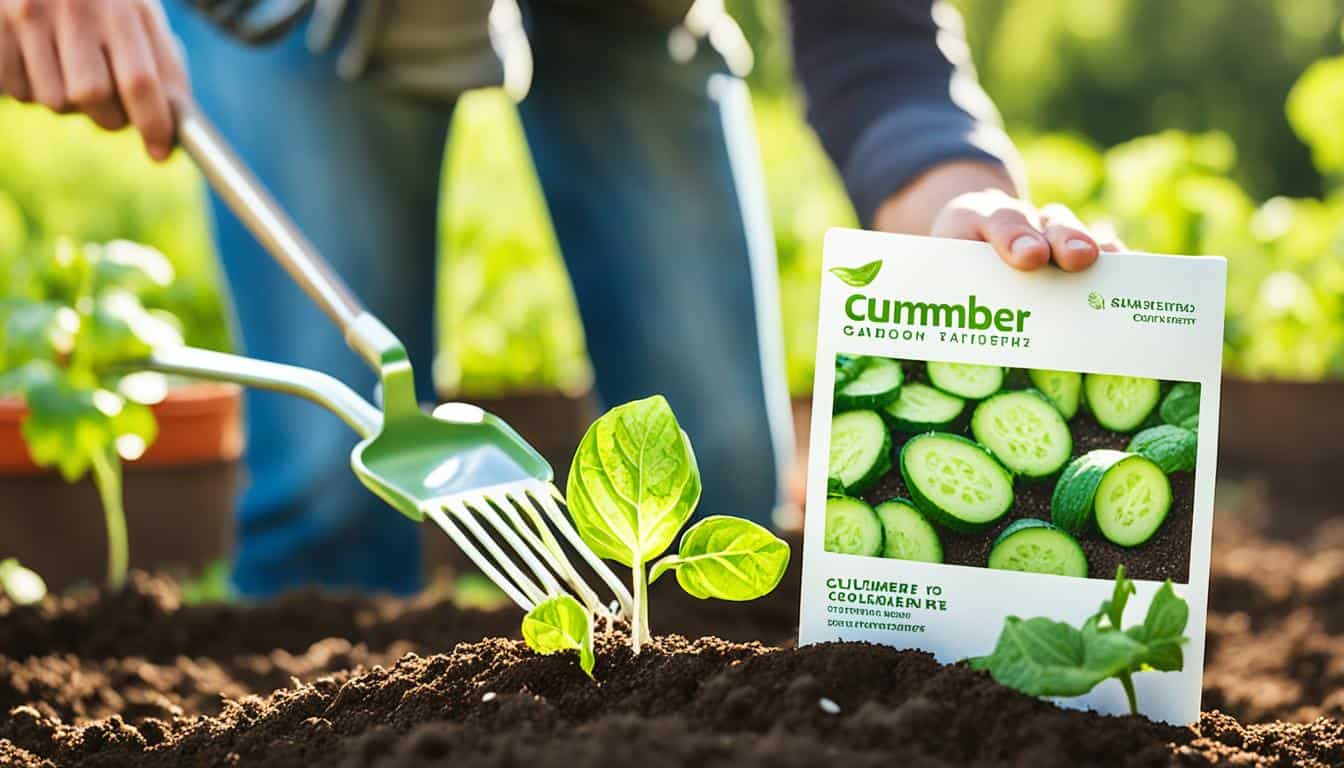
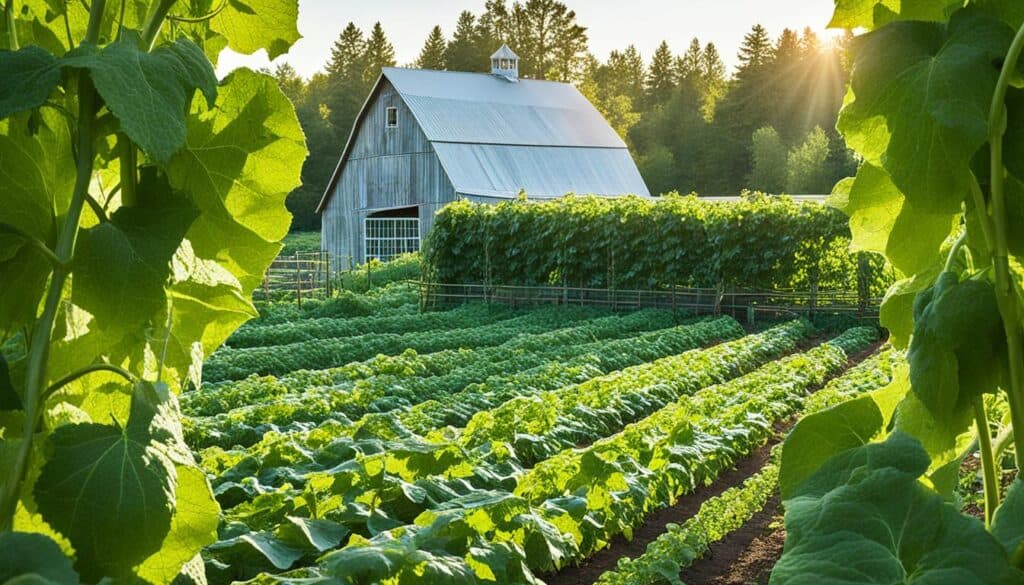
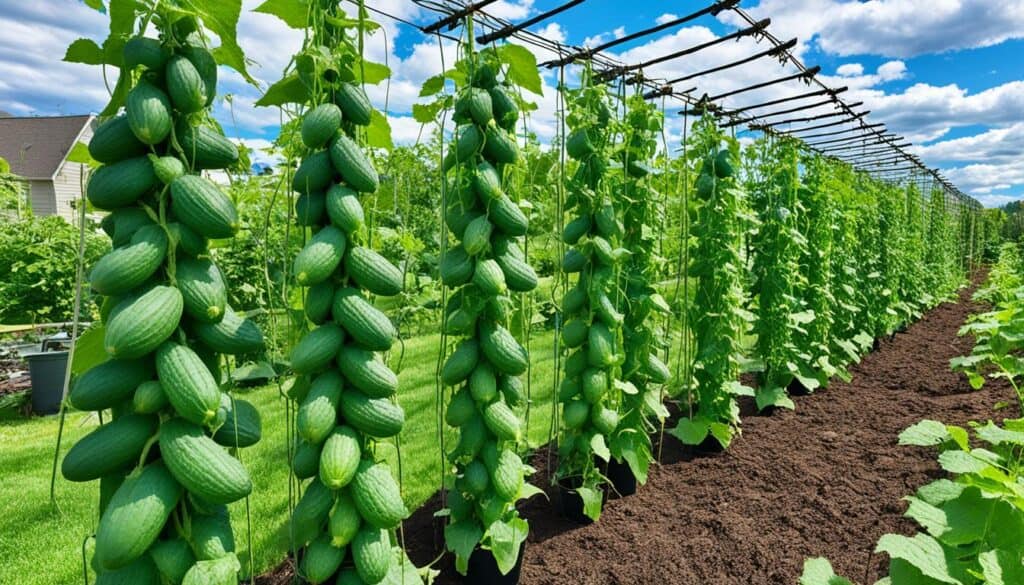
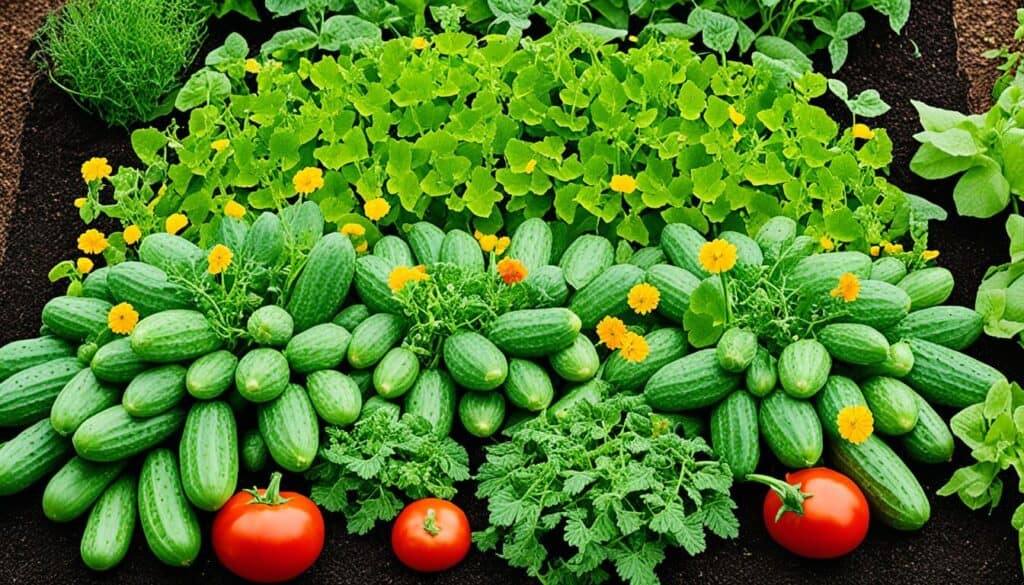
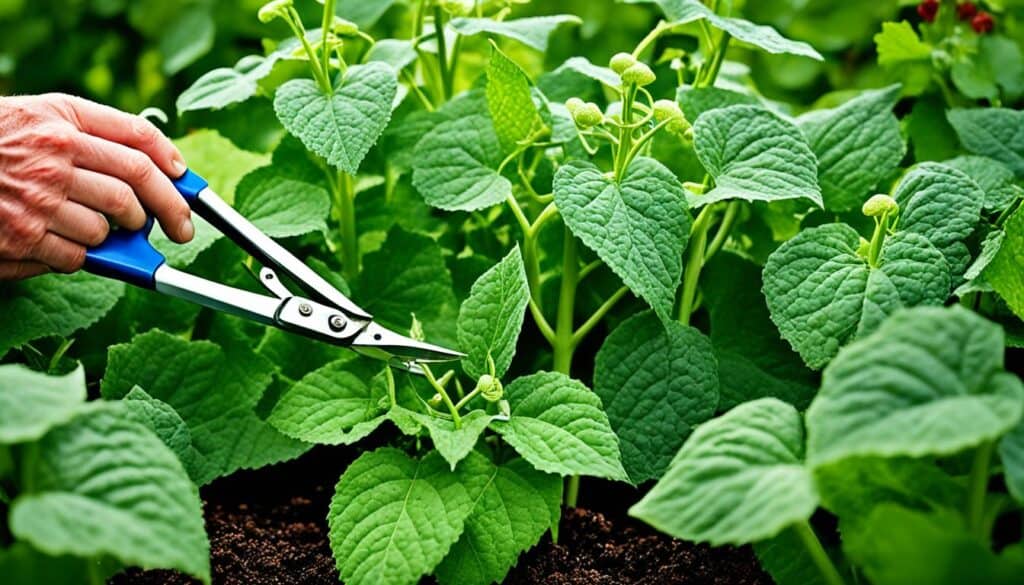



Leave a Reply